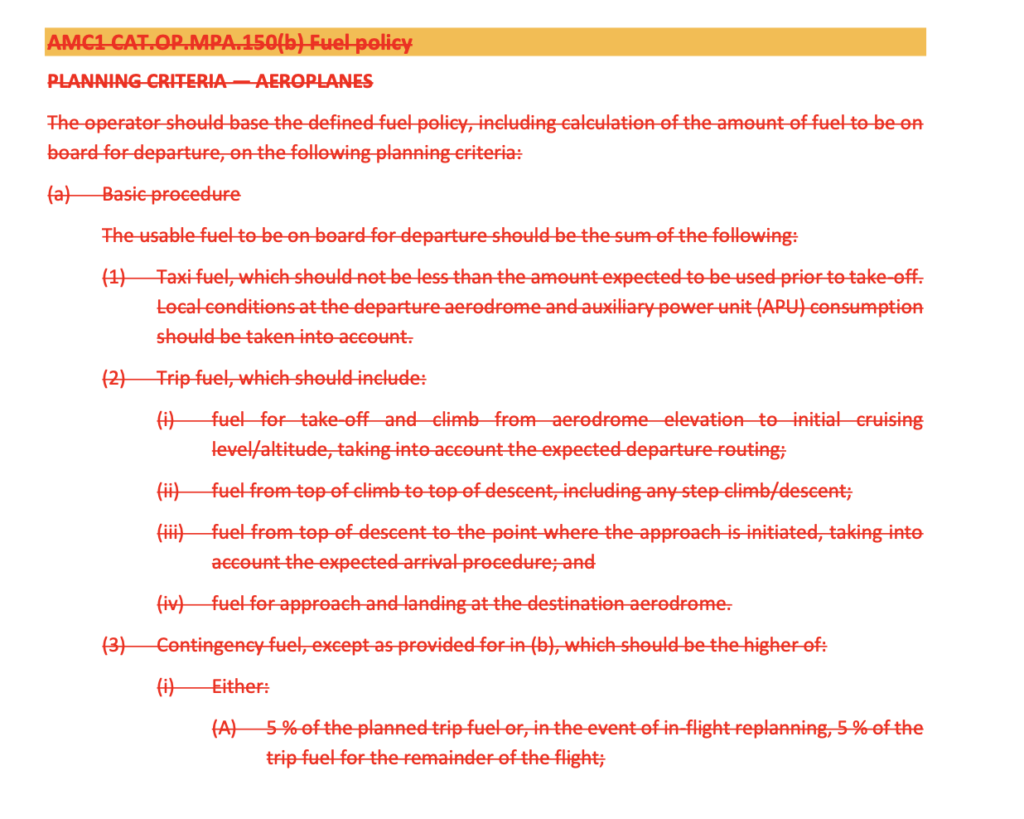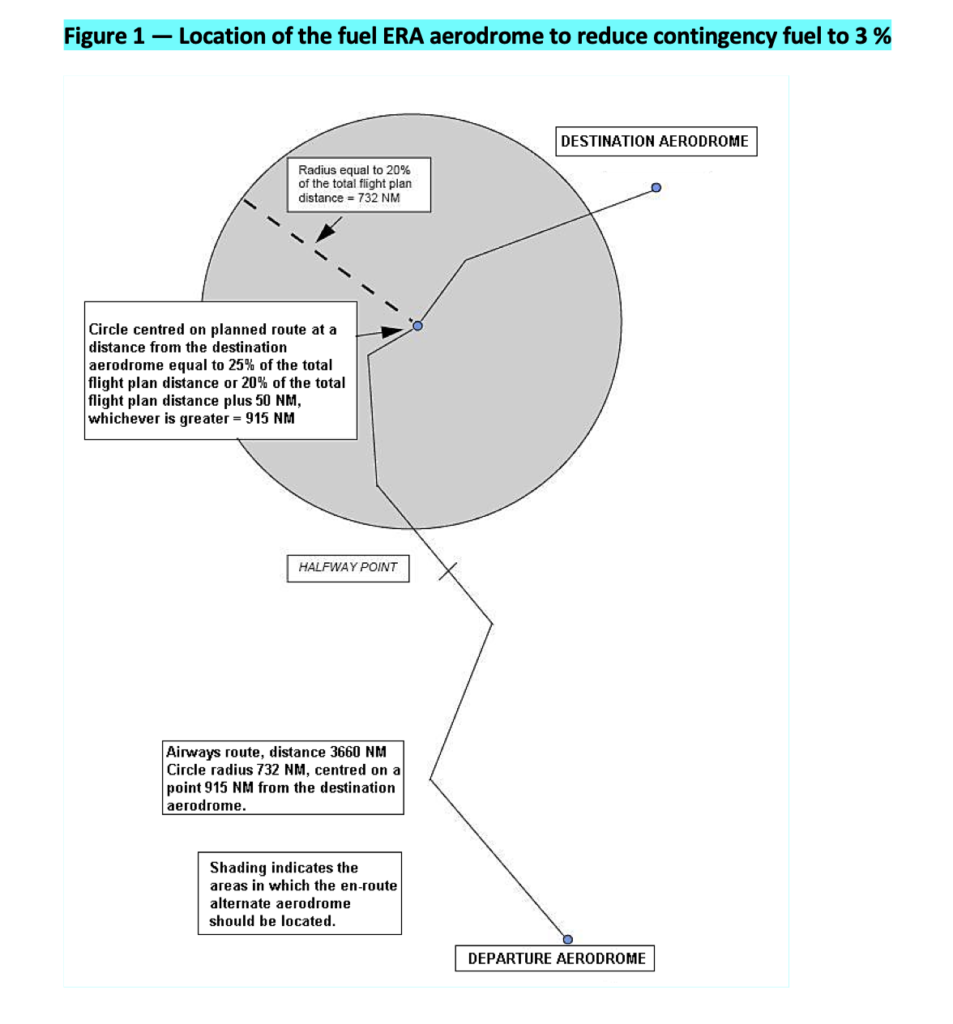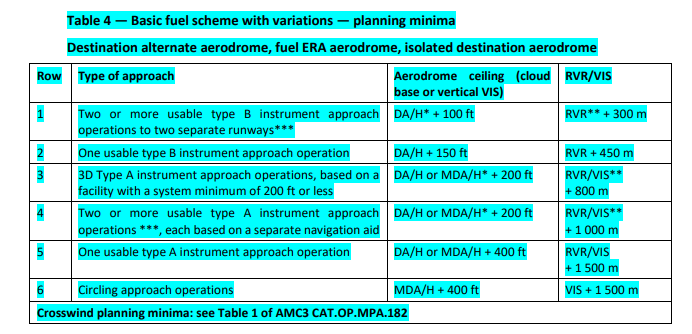So EASA have changed their fuel rules and the ‘Decision’ they have published ain’t an easy thing to read. Here is what we think it says, in plainer English, to help you work out what it all means for you.
We are no pros on fuel planning through so this is more of a heads-up that things are a-changing. For the full regulations you will need to dive in yourself and try to fathom it out, but hopefully this gives some info on bits to really look out for.
First of all, in EASA’s own words…
…What the change is all about?

Words and more words
They also say:
 Give it to me in plain English.
Give it to me in plain English.
- It will improve fuel efficiency.
- It will be nicer for the environment.
- It will apply from October 30 2022.
- The big change in fuel policy applies to Commercial Air Transport (CAT) operators (but there are a lot of changes for other folk in there too)
If you want to jump straight in and read it all yourself, then here is the link.
What’s changed then?
Remember the old Fuel Policy that we all know and love?
The one where you have to carry taxi fuel, trip fuel, fuel to get to your alternate, contingency fuel (and some additional bits in there about whether that needs to be 5% or 5 mins at 1500′, or 3% or if you can use STATCON…) plus your final reserve and any extra you might want…

Out with the red, in with the blue, the new fuel scheme, is confusing for you?
Well, that is out and in its place are three new fuel schemes –
- the Individual.
- the Basic.
- the Basic, with variations.
So the old fuel policy is chopped and there are three new schemes instead.
Here’s the deal with them. The first thing to know is that the individual and the basic + variations are both voluntary, meaning you’ll need to meet a bunch of criteria to opt for them. The basic is what you’ll be on if the other two don’t apply.
Oh, and should have said it earlier, but this only applies if you’re an EASA operator.
Any idea which fuel scheme to read up on?
If you’re not a CAT Operator (now that header picture makes sense, right?) then the Individual Fuel Scheme (and all the many, many pages of info referring to that) probably won’t apply to you. That’s not to say it isn’t useful to read and know about anyway.
If you know you don’t have particularly enhanced fuel monitoring capabilities then the basic scheme is the one for you, and this is not really different from the current fuel policy as we know it. There are however a lot of small changes which you will need to know about.
EASA say
 So let’s look at the schemes.
So let’s look at the schemes.
1. The Individual Fuel Scheme.
This applies to big operators with big fuel monitoring systems in place which let them say “I know how much fuel I need all the time because I fly there a lot, monitor it and know about all the possible changes and risks and all that stuff that might affect it!”
So EASA are all “well, if you meet all our criteria then we’re gonna trust that you do know better, and can take just what you need and that’ll be better for you and the environment.”
OK, there might be a bit more to it than that, but in a nutshell if you’re a big operator and think this might apply then dig in and read all the new blue and see if you can opt for this scheme.
If you know this doesn’t apply, then read on.
2. The Basic Scheme.
Ah now this is more familiar. It is basically our old Fuel Policy made simple. 5% for your contingency. Done.
Here’s the actual contingency bit for reference:
For contingency fuel, calculate for unforeseen factors either: whichever is the higher; (1) 5 % of the planned trip fuel or, in the event of in-flight re-planning, 5 % of the trip fuel for the remainder of the flight; or (2) an amount to fly for 5 minutes at holding speed at 1 500 ft (450 m) above the destination aerodrome in standard conditions,
This is not voluntary. The other two are, and if you don’t go for either of them then this is the policy you’ll need to apply.
3. The Basic with variations.
From what we can see, those variations really apply to the contingency and whether you can reduce to 3% or use STATCON, which is based on whether you have some sort of monitoring program in place, amongst other things.

Same, but bluer
Seems like a lot of blue just for that?
There is a lot because the two voluntary schemes have a lot of points attached to them which you need to know about if you’re planning on applying for one of those schemes.
Aside from the big policy changes, there are some changes and clarifications to definitions and what have you which are worth a read.
Do you need to read the Explanatory Note?
Not unless you really want an in-depth explanation as to why they need the new AMC and GM (acceptable means of compliance and guidance material) on fuel/energy planning, and a whole long list of references.
You can read it here if you do want to.
Annex I
This is the changes to the definitions annex. It is fairly short (they’ve removed acronyms) and made a few definition changes.
You can read it here, but you’re better off reading the full definitions annex here if it’s definitions you’re after.
Here’s one we found interesting:
- Relevant safety information that might affect the safety of the flight: unforeseen hazards
They’ve published a nice list here of stuff to think about (which you were probably were anyway but just incase) it means stuff like unexpected ATC delays, met conditions which weren’t forecast, sudden obstructions on the runway, failure of some bit of the airplane that means you suddenly need a lot more runway. Sudden acts of nature that you didn’t expect…
The other Annexes
We jumped straight in to Annex IV because it is the Commercial Air Operators annex, and they did say at the start that most of the changes apply to this. If you are not a CAT Operator then take a browse through the annex that does apply.
This contains all the info on the new schemes and the changes, criteria for opting for them etc. so this is what you need to read!
Some other bits worth looking out for.
- Alternate Planning: We aren’t here to get into the nitty-gritty of the changes but someone very helpful and with more knowledge on it that us said that this “basically rewrites everything we learned” about flight planning. One of the big rewrites is on the Alternate Planning.
- The old ‘step-down’ method of alternate planning doesn’t apply anymore. Instead it must be looked at individually each time.
- Wind gusts also need to be considered.
- Take a look at the tables (here’s the one for the basic + variations scheme) to get a better idea.

Alternate planning changes
There are also some nicely updated or reclarified definitions throughout so even if the new optional schemes don’t apply to you, its good opportunity to remind yourself about certain meanings which apply to any fuel policy, even non-EASA ones.
- Appropriate Meteorological information: There is a whole lot of blue here and they seem to have updated the definition on what this means and where you can get this weather from. Basically you can reproduce information from a reliable “weather man” source so long as you are just changing the layout, not the content.
- Reliable means it as some sort of quality assurance in terms of accuracy and integrity.
- You can also use supplementary weather info – like some nice colourful charts.
- Verifying weather conditions for adequate aerodromes: You have two choices, and the requirement for RFFS seems to have been removed from the adequate definition:
- Adequate This means an aerodrome that you can fly to and use because its runway characteristics and anything else relevant meets your performance requirements. You don’t have to consider weather conditions to decide if an aerodrome is adequate.
- Weather permissible You do need to consider the weather to determine if an adequate aerodrome is weather permissible for your planning purposes.
- Minimum Fuel: This is worth a read, and because we think it is worth a read, we’ve recreated it here for you so you can just read that without everything else around it, if you so wish.
Is there a good way to read this?
It is a fairly unreadable document. The amount of blue and red makes it quite hard to work out what applies to you and what doesn’t. We suggest finding a way to separate the scheme that applies to you from the rest, and then read through the definitions and sections along side your current fuel policy to identify what has specifically changed.
Still totally confused?
We are too if we’re being totally honest. There are some big changes going on here and working out which fuel scheme applies to you is just step on.
EASA are holding a Webinar on this later in the year (Currently planned for July 7). You can register for it here.
If you’re not already on it then it might be worth signing up to the EASA community network because they post updates, and folk have discussions on all things EASA on here so you might find more answers here.
There are some bits we were confused on so if you spot any errors or issues in this, please let us know at team@ops.group
More on the topic:
- More: Ops to Europe: How to Get a Third Country Operator (TCO) Approval
- More: EASA Removes CZIBs: Middle East Risk Gets Harder to Read
- More: Why EASA has Withdrawn Airspace Warnings for Iran and Israel
- More: Russia: Aircraft Shot Down, New EASA Airspace Warning
- More: Winter Ops: Fun Fuel Facts
More reading:
- Latest: Venezuela & Caribbean Airspace Update
- Latest: ReFuelEU: Europe’s new anti-tankering rules explained
- Latest: US CBP biometrics: BizAv rollout still unclear
- Safe Airspace: Risk Database
- Weekly Ops Bulletin: Subscribe
- Membership plans: Why join OPSGROUP?











 Get the famous weekly
Get the famous weekly 






Many thanks dear team @ops.group 😊 for the update!
Good Morning to you, my name is Markus Trahbüchler (former pilot with Austrian Airlines for more than 15 years and currently working as a flight dispatcher) and I am currently studying “aviation management” working on my master thesis concerning the new EASA Fuel Schemes questioning “How will part CAT (= Commercial Air Transport) operators implement the new EASA fuel schemes into their operation?”
I am planning expert interviews with different kinds of operators and I am always looking for information / updates concerning the former RMT.573 besides the EASA stuff like webinars or infos published via the EASA Air Ops Community homepage.
@ Rebecca Lougheed: as you fly A380 may I ask you how the operator you are working for plans to implement the new fuel schemes?
I am still looking for further interview partners concerning my master thesis and would be pleased if you could write an answer to me!
Thank you very much in advance!
Best regards
Markus Trahbüchler
Klosterneuburg (near Vienna), Austria